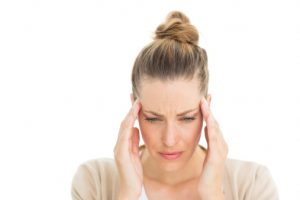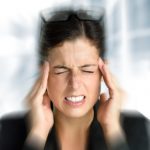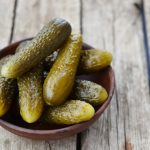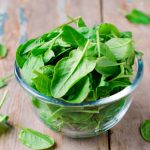 There are all sorts of triggers for migraines, but for many sufferers, tyramine rich foods seem to active the problem.
There are all sorts of triggers for migraines, but for many sufferers, tyramine rich foods seem to active the problem.
Tyramine is a naturally occurring compound that comes from the amino acid called “tyrosine.” It acts as a releasing agent that impacts our neurotransmitters. Neurotransmitters are brain chemicals that play a major role in our bodily functions.
Advertisement
Migraines are severe headaches that involve constant throbbing that normally affect one side of the head and are accompanied by various other symptoms, such as dizziness, nausea, and blurred vision.
A large number of people who suffer from migraines are unable to function when an attack occurs. Some people prone to these types of headaches experience a migraine once or twice a month. Believe it or not, about 14 million Americans experience migraines on a daily basis. According to the Migraine Foundation about 18 percent of American women suffer from migraines and six percent of men experience them.
The story behind tyramine
 Studies on food and headaches date back to the 1920s; however, research on foods triggering migraines – specifically on foods containing tyramine – have been more common in recent years. Most of the research is based on diet manipulation and patient feedback.
Studies on food and headaches date back to the 1920s; however, research on foods triggering migraines – specifically on foods containing tyramine – have been more common in recent years. Most of the research is based on diet manipulation and patient feedback.
Some people are really surprised to find out that the horrible pain they have been experiencing is from the food they eat. In many cases, the amino acid can cause an increase in blood pressure and then trigger a migraine headache in tyramine-sensitive people. Tyramine is generally associated with aged foods, like cheese, so avoiding such foods is key. If you suspect foods are giving you migraines, you might want to consider writing down everything you eat and tracking when you get a migraine (or even a simple headache). Keep in mind that tyramine can also be found in beverages. It is also important to note that some tyramine rich foods interact with certain medications. It’s best to discuss this with your doctor, especially if you are taking any antidepressants.
While research shows that tyramine is the main source responsible for food-related migraines, some foods that contain additives like nitrates have also been known to trigger headaches in some people. Also, if you consume a lot of caffeine and then suddenly stop, you can experience caffeine withdrawal headaches or even migraines.
People are often amazed at how eliminating just one item from their diet can get rid of their excruciating migraines for good.
Tyramine rich foods that may cause migraines
There is a long list of foods that can trigger headaches or migraines, but it does not mean that if one gives you a migraine, all foods with tyramine content will give you a migraine. This is because each food item has a different level of tyramine in it. For example, tyramine levels in cheese vary a lot depending on the different ways the cheeses are processed, on the fermentation systems, aging processes and condition of the product. The higher the tyramine, obviously the higher the chances you will suffer a migraine if you are sensitive to the compound. Processed Swiss, Parmesan, feta, Muenster, mozzarella, Stilton, cheddar, Gorgonzola, Brie and blue cheeses usually contain high levels of tyramine.
 Here are some other foods that cause migraines:
Here are some other foods that cause migraines:
Vegetables
- Pickles
- Olives
- Beans
- Chili peppers
Fruits
Meats
- All preserved or processed meat
- Bacon
- Sausage
- Hot dogs
- Aged chicken liver
- Aged cheeses
- Whole milk
- Sour cream
Bread
- Yeast breads
- Soft pretzels
- Pizza
Beverages with chocolate in them, as well as caffeinated beverages, beer on tap and red wine can also be migraine triggers. Sauerkraut, soy sauce, and any sauces containing fish or shrimp may contain tyramine.
Other migraine triggers you should know
Although food can be the cause of migraines for a lot of people, there can be other reasons for an attack of this kind. It’s important to understand what could be triggering your symptoms if you are suffering.
Studies have shown that weather, hormones, physical activity, stress, lack of sleep and over-use of medications can cause migraine headache and pain.
There is a theory linking headache pain and changes in the weather; it is a need to seek a safer environment due to the uncomfortable environmental conditions. That fact is: extreme heat and cold seem to trigger severe headaches in some people. Evidence indicates that a lot of women experience migraines during menstruation because of a big fluctuation in female sex hormones.
 While stress induced migraines and lack of sleep require little explanation, physical activity and over-use of medications are a little more complex. A recent study showed that 38 percent of migraine sufferers had exercise related migraines at some point. This is due to the fact that they went overboard when working out. In many cases they hurt their necks or back, which ultimately led to the migraine. As for medications, often migraine sufferers start with the occasional attack, but over-use of pain-relieving medications actually cause more migraines to occur.
While stress induced migraines and lack of sleep require little explanation, physical activity and over-use of medications are a little more complex. A recent study showed that 38 percent of migraine sufferers had exercise related migraines at some point. This is due to the fact that they went overboard when working out. In many cases they hurt their necks or back, which ultimately led to the migraine. As for medications, often migraine sufferers start with the occasional attack, but over-use of pain-relieving medications actually cause more migraines to occur.
Tips to help identify migraine triggers
One of the most effective ways to help identify migraine triggers is through what is referred to as the elimination diet. It is designed to help you track unusual pain triggers.
You can start by developing a diet that includes pain-safe foods and avoids all the foods that could potentially cause migraine headaches. You can add new foods one at a time to see if migraine symptoms occur.
Here are a few tips to help you pinpoint triggers:
- Foods that cause headaches were eaten within three to six hours of the attacks.
- The headache did not show up until a large amount of the food was consumed.
- Tolerance can change depending on time. For example, a woman might be able to eat half a box of chocolates with no problem, but a single chocolate triggers a migraine as she approaches her period.
- Triggers can change over time.
Tracking what you eat, when you eat it, how much you eat, and how you feel after you have a meal or snack can seem tedious, but it’s a system that has worked for literally millions of migraine sufferers.
Migraine diet-foods that help your headaches
Over time food scientists, in consultation with doctors, have developed a list of pain-safe foods for migraine patients. Below you will find some examples from that list.
 Rice, especially brown rice
Rice, especially brown rice- Cooked green vegetables, such as broccoli, spinach, Swiss chard, or collards
- Cooked orange vegetables, such as carrots or sweet potatoes
- Cooked yellow vegetables, such as summer squash
- Cooked or dried non-citrus fruits: cherries, cranberries, pears, prunes (not citrus fruits, apples, bananas, peaches, or tomatoes)
- Modest amounts of salt, maple syrup, and vanilla extract are usually well tolerated
While many of these foods do not contribute to migraines, they don’t contribute to any other painful conditions either.
When you think about it, foods causing headaches to this degree sounds impossible, but the compounds that we consume on a daily basis can have a dramatic impact on the way our body functions. Research has shown that just like ingesting tyramine can cause terrible headaches for some people, there are nutrients and minerals we can consume that will relieve our pain. For example, magnesium has been known to relax our blood vessels, which can protect us from pain headaches, including those associated with migraines. Herbs like ginger root, rosemary and marjoram are also said to be beneficial in relieving headache pain.
We all need to eat in order to thrive, but we are learning more and more about the power that food has over our body, particularly the transmission of pain.
Related Reading:
Natural ways to treat chronic migraine headaches at home
Chronic migraine headaches affect nearly seven million Americans, so there is a strong need for natural treatment. A migraine headache is described as a headache that occurs more than 15 times within a month… Continue reading…
Advertisement
When a headache could be a warning sign of something else
If you have ever experienced a migraine, you’re familiar with the throbbing pain and anguish that come with it. If you are an older person who suffers from migraines, you are considered more likely to experience significant… Continue reading…
Sources:
http://www.charismanews.com/opinion/52270-this-element-in-foods-can-trigger-migraines
http://www.migrainetrust.org/factsheet-migraine-triggers
http://www.migraineresearchfoundation.org/about-migraine
http://escholarship.org/uc/item
http://www.webmd.com/migraines-headaches/guide/tyramine-and-migraines
http://www.achenet.org/resources/migraine_management__migraine_trigger_foods
http://www.healthline.com/health/migraine/triggers


